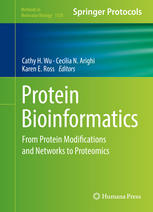

Most ebook files are in PDF format, so you can easily read them using various software such as Foxit Reader or directly on the Google Chrome browser.
Some ebook files are released by publishers in other formats such as .awz, .mobi, .epub, .fb2, etc. You may need to install specific software to read these formats on mobile/PC, such as Calibre.
Please read the tutorial at this link: https://ebookbell.com/faq
We offer FREE conversion to the popular formats you request; however, this may take some time. Therefore, right after payment, please email us, and we will try to provide the service as quickly as possible.
For some exceptional file formats or broken links (if any), please refrain from opening any disputes. Instead, email us first, and we will try to assist within a maximum of 6 hours.
EbookBell Team

4.1
10 reviewsThis volume introduces bioinformatics research methods for proteins, with special focus on protein post-translational modifications (PTMs) and networks. This book is organized into four parts and covers the basic framework and major resources for analysis of protein sequence, structure, and function; approaches and resources for analysis of protein PTMs, protein-protein interactions (PPIs) and protein networks, including tools for PPI prediction and approaches for the construction of PPI and PTM networks; and bioinformatics approaches in proteomics, including computational methods for mass spectrometry-based proteomics and integrative analysis for alternative splice isoforms, for functional discovery. Written in the highly successful Methods in Molecular Biology series format, chapters include introductions to their respective topics, lists of the necessary materials and reagents, step-by-step, readily reproducible laboratory or computational protocols, and tips on troubleshooting and avoiding known pitfalls.
Cutting-edge and thorough, Protein Bioinformatics: From Protein Modifications and Networks to Proteomics is a valuable resource for readers who wish to learn about state-of-the-art bioinformatics databases and tools, novel computational methods, and future trends in protein and proteomic data analysis in systems biology. This book is useful to researchers who work in the biotechnology and pharmaceutical industries, and in various academic departments, such as biological and medical sciences and computer sciences and engineering.